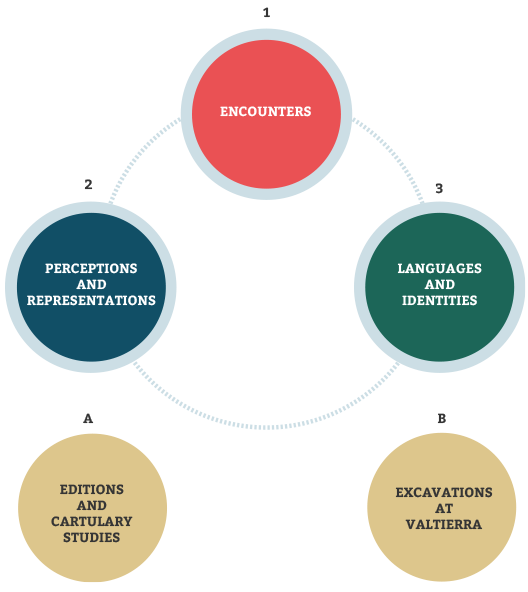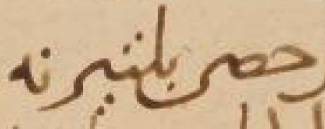The societies that these regions hosted can all be described as ‘societies on the edges’, albeit for different reasons: the Anglo-Saxons had a clear sense of their geographical position on the edge of the known world, as illustrated by the words that the eighth-century writer Bede used to open his Historia ecclesiastica gentis Anglorum: ‘Britain, once called Albion, is an island in the ocean and lies to the north-west, being opposite Germany, Gaul and Spain, which form the greater part of Europe, though at a considerable distance from them’ (HE, I.1). Traditional historiography has regarded the eastern borders of the Frankish world, the territories to the east of the Middle Rhine, as a frontier space, which has led to them being treated as a periphery characterized by archaic features, especially when compared with the core region of the grand domaine between the Loire and the Rhine. (RÖSENER, 1993; FREUDENBERG, 2013). For their part, the northern polities of early medieval Iberia were on the edge not just of a different society, but of a stronger polity, that of al-Andalus. The ‘frontier’ (intended as a rather fluid concept at this stage) between the northern Christian territories and the southern Islamic state shifted repeatedly in the early medieval period, making our definition of ‘societies on the edges’ even more meaningful (MANZANO 1991; LARREA and LORENZO 2012; LARREA and PASTOR 2012; LARREA 2013). Within al-Andalus itself during the Umayyad period we encounter different ethnic, religious and linguistic communities which lived ‘on the edge’ of each other, resulting in innumerable instances of cultural hybridization.
CONNECT explores events or situations in which it is possible to observe meetings and interactions of people from different geographical areas, trying to examine how and why these interactions occurred. Special attention is paid to the practicalities of such encounters, including long-distance travel, systems of communication and hospitality, while also bearing in mind the numerous possibilities for encountering ‘others’ that frontier societies (or ‘societies on the edges’) offered on a local level and on a more regular basis. The project thus aims to cast a wide net: the encounters we examine range from those involving diplomacy and exchanges between rulers of different polities to those occurring in local rural and urban societies.
Much research on early medieval ethnic identities over the last three decades has shown the role played by others, that is those who are perceived as external to a given group, in the formation of that group’s identity. But while these studies have dealt mainly with post-Roman societies (e.g. POHL and REIMITZ, 1998), our aim is to look further ahead in time, by focusing on the period between the eighth and the eleventh centuries, and to include in this analysis societies located further west than those that have attracted most of the attention in this area of research. We are interested in perceptions and representations of ‘others’ as the result of occasional encounters, but also in those that sprang from more sustained ‘co-existence’ of people speaking different languages or professing different religions, as was indeed the case in frontier areas of the Iberian Peninsula as well as within al-Andalus.
The third theme builds on the previous one while also developing a line of research that various members of the project team have been pursuing in recent years. In most discussions of early medieval ethnic identities, language has been treated somewhat suspiciously, as scholars have been understandably keen to clear the ground from old-fashioned misconceptions about the role of language in defining ‘national character’ (GEARY, 2013). Yet, while one should be alert to the dangers of falling prey to nationalistic traps, one should not underestimate the importance of the complex, multifaceted and always evolving relations between languages and identities. In our earlier investigations we have explored the interactions between Latin and vernaculars in charters produced in England and the eastern Frankish territories (LARREA, 2019; GALLAGHER, ROBERTS and TINTI, 2021). This research has shown that in those texts language was indeed used as a marker of social distinction (ROBERTS and TINTI, 2020). CONNECT aims to enlarge our geographical scope by including evidence from the Iberian Peninsula, a region which, given its remarkable multicultural and multilingual character (including Ibero-Romances, Basque and Arabic, as well as written Latin), is bound to cast invaluable light on the complex relations between languages and identities in early medieval western Europe. Our project thus aims to contribute to the current burgeoning of research into historical multilingualism (e.g. MULLEN and JAMES, 2012) and the relations between the written and the spoken word (BANNIARD, 1992; WRIGHT, 2002; GARRISON, ORBAN and MOSTERT, 2013).
Our past research on charters has shown the importance of properly understanding the rationale behind the origins and preservations of documentary sources, especially those which have come down to us in later collections known as cartularies.
Our editing of (and comparative work on) medieval cartularies produced at San Millán de la Cogolla, Sahagún and Worcester have led to pioneering open-access digital editions (www.ehu.eus/galicano) of texts that had been poorly served by earlier editors presenting a deeper understanding of the circumstances which led to the production of such compilations (TINTI, 2019; AGÚNDEZ, 2019; PETERSON, 2019). In order to provide solid foundations for our themes we are renewing our efforts to provide rigorous editions and detailed studies of cartularies and documentary dossiers from England, the Middle Rhine, and northern Spain, including those from Froncea, Piasca and Santo Domingo de la Calzada. This work is needed to gain a better understanding of the documentary sources we use in our research, to establish their degree of authenticity, and to recognize possible later textual interventions.
Furthermore, this work package is at the base of our research on language contact in charters which only survive in later copies: the study of their philological features must be conducted bearing in mind the (often presumed or alleged) date of the records, together with that of successive copying phases and possible interpolations.

CONNECT’s interdisciplinary character becomes especially visible in its second foundational work package, wich covers four campaigns of archaeological excavations at Valtierra (Navarre), in an area that fully embodies our concept of ‘society on the edge’. Valtierra lies in the Ebro valley, circa 15 km from Tudela. The area was already inhabited in the Iron Age and its importance in the Roman period is attested by various archaeological finds. During the Islamic period the territory was part of Tudela’s hinterland and it is during this period that the earliest extant mention of the toponym – Baltīra (بلتيرة) – can be found, specifically in a tenth-century Arabic chronicle preserved in a manuscript dating to the twelfth century:

ˤArīb ibn Saˤīd (d. 981): Ijtiṣār tā’rīj al-Ṭabarī (Continuation of the History of al-Ṭabarī). Detail of Forschungsbibliothek Gotha, Ms. orient A 1554, fol 89v. Available on-line at https://dhb.thulb.uni-jena.de/rsc/viewer/ufb_derivate_00013744/Ms-orient-A-01554_000089b.tif
At the time Valtierra was in a highly porous frontier region where contacts between Christian and Muslim populations were continuous. With the Navarro-Aragonese conquest of 1119, this territory was definitively removed from the political control of al-Andalus.
CONNECT is actively participating in archaeological excavations at Valtierra, by virtue of an agreement between the University of the Basque Country UPV/EHU and the municipality of Valtierra, which enables our team member, Dr Jesús Lorenzo, together with archaeologists Juan José Bienes y Óscar Sola, to direct the excavation campaigns between 2022 and 2025. This allows us to literally recover a settlement which hosted a society on the edge of different polities, religions and languages.
Periodical updates on the excavation campaigns can be found here.
Preliminary Bibliography
AGÚNDEZ SAN MIGUEL, L. (2019), ‘Reacción y defensa en la producción de los cartularios de Sahagún’, in From Charters to Codex: Studies on Cartularies and Archival Memory in the Middle Ages, ed. R. Furtado and M. Moscone, Turnhout, pp. 99–118.
BANNIARD, M. (1992), Viva voce: communication écrite et communication orale du IVe au IXe siècle en Occident latin, Paris.
FREUDENBERG, S. (2013), Trado atque dono. Die frühmittelalterliche private Grundherrschaft in Ostfranken im Spiegel der Traditionsurkunden der Klöster Lorsch und Fulda (750 bis 900), Stuttgart.
GALLAGHER, R., ROBERTS, E. and TINTI, F., eds (2021), The Languages of Early Medieval Charters: Latin, Germanic Vernaculars, and the Written Word, Leiden: Brill.
GARRISON, M., ORBAN, Á, P. and MOSTERT, M., eds (2013), Spoken and Written Language: Relations Between Latin and the Vernacular Languages in the Earlier Middle Ages, Turnhout: Brepols.
GEARY, P. (2013), Language and Power in the Early Middle Ages, Waltham: Brandeis University Press.
HOLMES, C. and STANDEN, N. (2018), ‘Introduction: towards a global Middle Ages’, in The Global Middle Ages, ed. C. Holmes and N. Standen, Past and Present 238, Supplement 13, pp. 1–44.
LARREA, J. J. (2013), ‘Du Tiraz de Cordoue aux montagnes du Nord. Le luxe en milieu rural dans l’Espagne chrétienne du haut Moyen Âge’, in Objets sous contrainte. Circulation des objets et valeur des choses au Moyen Âge, ed. L. Feller and A. Rodríguez, Paris: Éditions de la Sorbonne, pp. 43–61.
LARREA, J. J. (2019), ‘Escribir el espacio entre la auctoritas, la lengua hablada y el régimen agrario: campus en los fondos documentales de Wissembourg, Lorsch y Fulda entre los siglos VIII y mediados del IX’, Studia Historica. Historia Medieval 37/1, pp. 53–78.
LARREA, J. J. and PASTOR, E. (2012), ‘Alaba wa-l-Quila: la frontera oriental en las fuentes escritas de los siglos VIII y IX’, in Asturias entre visigodos y mozárabes, ed. L. Caballero, P. Mateos and C. García de Castro Valdés, Anejos de Archivo Español de Arqueología, Madrid: CSIC, pp. 307–29.
LARREA J. J. and LORENZO, J. (2012), ‘Barbarians of Dâr al-Islâm: the Upper March of al-Andalus and the Western Pyrenees in the eighth and ninth centuries’, in La Transgiordania nei secoli XII-XIII e le ‘frontiere’ del Mediterraneo medievale, ed. G. Vannini and M. Nucciotti, Oxford: Archaeopress, pp. 277–88.
MANZANO MORENO, E. (1991), La frontera de al-Andalus en época de los Omeyas, Madrid: CSIC.
MULLEN, A. and JAMES, P., eds (2012), Multilingualism in the Graeco-Roman World, Cambridge: Cambridge University Press.
PETERSON, D. (2019) ‘Order and disorder in the cartularies of San Millán de la Cogolla’, in From Charters to Codex: Studies on Cartularies and Archival Memory in the Middle Ages, ed. R. Furtado and M. Moscone, Turnhout: Brepols, pp. 119–34.
POHL, W. and REIMITZ, H., eds (1998), Strategies of Distinction: The Construction of Ethnic Communities, 300–800, Leiden: Brill.
ROBERTS, E. and TINTI, F. (2020), ‘Signalling language choice in Anglo-Saxon and Frankish charters, c.700–c.900’, in The Languages of Early Medieval Charters: Latin, Germanic Vernaculars and the Written Word, ed. R. Gallagher, E. Roberts and F. Tinti, Leiden: Brill, pp. 188–229.
RÖSENER, W. (1993), ‘Strukturformen der adeligen Grundherrschaft in der Karolingerzeit’, in Strukturen der Grundherrschaft im frühen Mittelalter, ed. W. Rösener, Göttingen: Vandenhoeck & Ruprecht, pp. 126–180.
TINTI, F. (2019), ‘El papel de la memoria en la producción de los cartularios de Worcester’, in From Charters to Codex: Studies on Cartularies and Archival Memory in the Middle Ages, ed. R. Furtado and M. Moscone, Turnhout: Brepols, pp. 81–98.
WRIGHT, R. (2002), A Sociophilological Study of Late Latin, Turnhout: Brepols.

CONNECT
Societies on the Edges:
A Combinative Approach to Cross-Cultural Connections in Early Medieval Western Europe